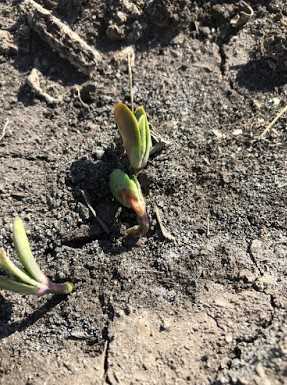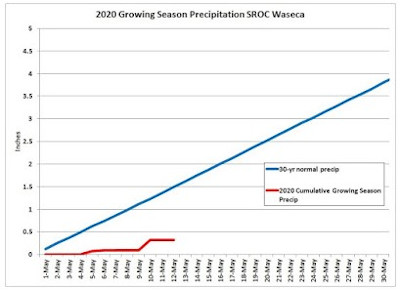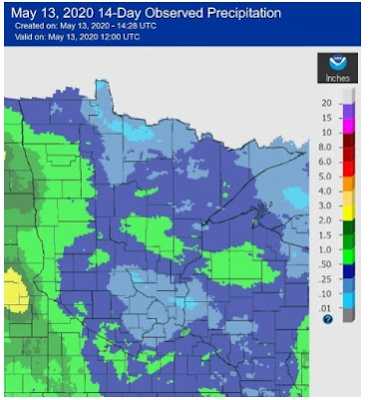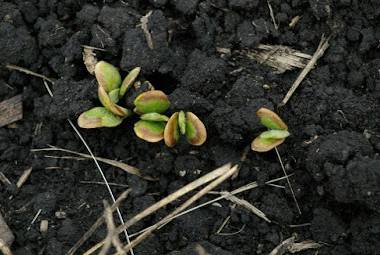By Jared Goplen, Dave Nicolai
Many soybeans in southern Minnesota were ready to emerge when the recent cold weather brought concerns of both frost and herbicide injury.
Most soybeans were still below ground and protected from freezing temperatures. However in some areas of the state, seedlings may show injury after extended contact with preemergence herbicides in the soil (Figure 1).

When evaluating soybean stands in the coming days, keep an eye out for herbicide-induced crop injury, especially in wetter areas of the state.
Dry areas unlikely to have herbicide injury
Much of southern Minnesota has had minimal precipitation since planting (Figures 2, 3). If less than 1/2” of rainfall has accumulated since application, preemergence herbicides have likely not been “activated.” This means there has not been enough rainfall to put the herbicides into soil solution, which is required in order for them to be taken up by weeds.

Figure 2. Accumulated vs. normal precipitation at SROC in
Waseca, MN in the spring of 2020.

Figure 3. Observed precipitation in Minnesota from
April 29 – May 13.
- The good news is that if herbicides have not been activated, they will not cause any crop injury to emerging soybeans, which is more likely with the recent cold temperatures. In order for crop injury to occur, the herbicide must be in soil solution.
- The bad news is that preemergence herbicides are also not going to provide weed control until they are in soil solution, meaning herbicides will not be effective until precipitation occurs.
- Most preemergence herbicides are resilient enough from UV degradation and volatility that they will stay on the soil surface until rainfall does occur, which will extend residual control later in the growing season.
- Fields will need to be scouted for weeds that emerge in the time being, and controlled with postemergence herbicides or a rotary hoe. Some corn preemergence herbicides that contain group 27 herbicides (eg. Balance Flexx, Acuron, etc.) can provide “reach-back” and control weeds after they emerge, but this can be unreliable.
Wetter areas likely to see herbicide injury
The recent cool weather slowed crop emergence and extended the time the crop was exposed to activated herbicides in the soil. This is especially the case along the western border of Minnesota (Figure 3).
In order for crop injury (and weed control) to occur, herbicides must be available in soil solution where they are biologically active. The likelihood of seeing crop injury varies with herbicide chemistry since some herbicides (e.g. metolachlor and acetochlor) contain crop “safeners”.
Soil-applied PPO inhibitors (e.g. Authority-, Valor-, and Sharpen-based herbicides) are more likely to cause crop injury. Soil texture can also influence the degree of injury. Soil texture affects the amount of herbicide bound to the soil and thus not available for plant uptake.
Is it frost or herbicide injury?
When you are evaluating stands in the coming days, how do you differentiate between freeze damage and herbicide-induced crop injury? Differentiating between herbicide and frost-induced injury symptoms is subjective. The best thing to look for is contact-injury symptomology of PPO herbicides that will result in necrotic lesions on the cotyledons and the hypocotyl arch (crook) of the recently emerged or emerging soybeans. These lesions are reddish to purplish to brownish in color (Figure 1). More advanced symptoms result in a girdling of the plant below the cotyledons, which can cause plant death. Additional photos and descriptions can be found at: http://extension.agron.iastate.edu/weeds/mgmt/2005/soilppo2.shtml.
Frost injury is due to radiation of heat away from the plant and unlike injury from preemergence herbicides, frost injury is more likely when soils are dry and humidity is low. Any necrosis from frost injury will likely be more uniform, and may lack any discoloration on the cotyledons or developing unifoliate leaves. Soybeans that were just emerging with the hypocotyl arch exposed were at the greatest risk for frost damage. Soybean plants that have soft, mushy, or pinched hypocotyls are unlikely to survive from frost injury. Additional information on frosted soybeans can be found at: https://extension.umn.edu/growing-soybean/spring-frost

Seed treatments containing ILEVO® fungicide/nematicide often cause cotyledons to develop dark brown edges. Don’t mistake this cosmetic damage for herbicide or frost injury (Figure 4).
Evaluate stands next week
Regardless of the cause(s) of the soybean injury, the affected fields should be left alone for a week before making final evaluations. Evaluations should be based on new growth from the main growing point or axillary buds. The next week will provide warmer temperatures that will make surviving plants obvious and stand evaluation easier.
If any replants are necessary, it is recommended to minimize soil disturbance to increase the value of the previously applied herbicides. The herbicide label is the final authority but soybeans can often be replanted into treated soil. The more disruption of the soil surface (ie. reworking the field) will dilute the existing herbicide and likely stimulate new weed emergence. If necessary, other residual products are available that can be applied to later-stage soybeans (e.g. Site of Action number 15).
Source : umn.edu